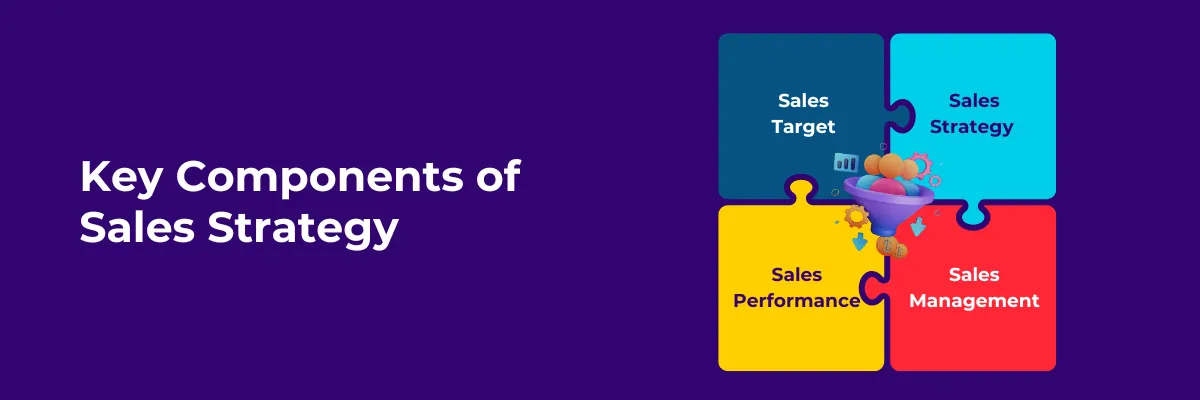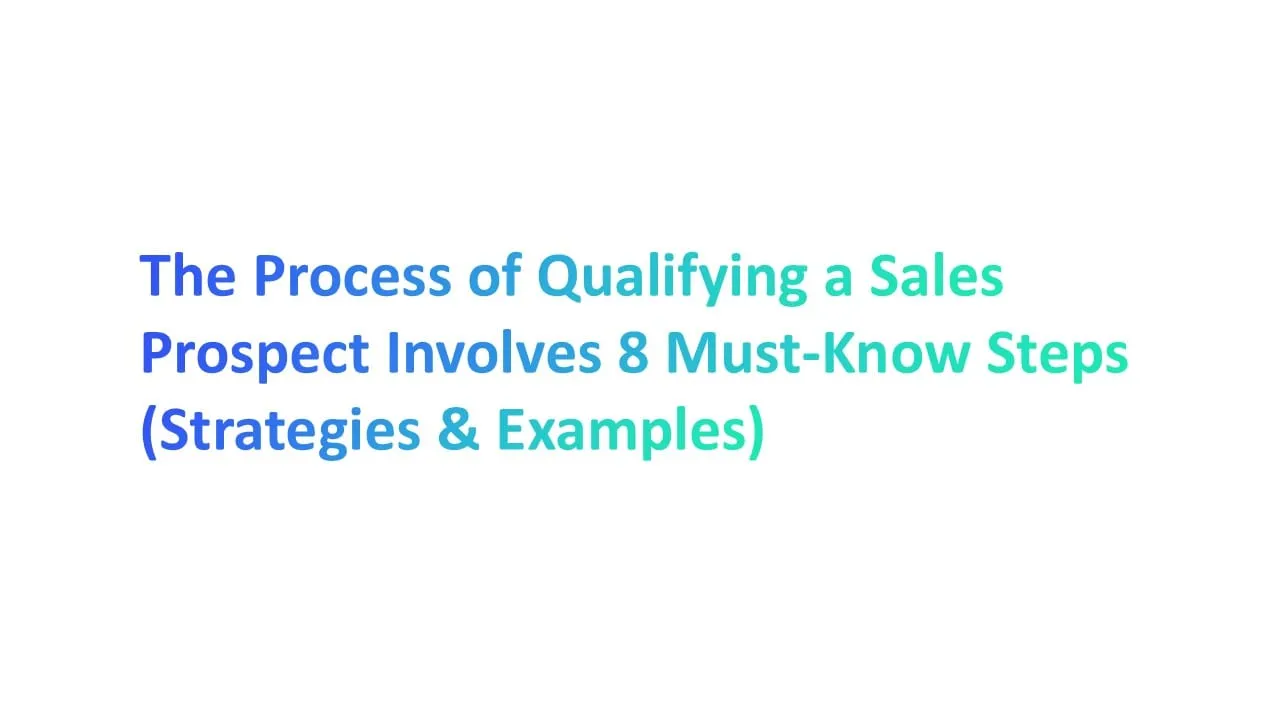A successful sales strategy is essential for businesses aiming to grow and increase sales revenue. The components of a sales strategy play a crucial role in driving performance, from defining sales goals to understanding target customers and crafting a sales process that works.
A well-structured sales strategy helps sales teams stay aligned with company objectives and effectively reach prospective customers. According to a study by HubSpot, companies with a clear sales strategy see 33% higher win rates than those without one.
Whether you're using inbound sales strategies or outbound sales strategies, the goal remains the same: to convert leads into loyal existing customers. Understanding the sales cycle and how to optimize it through thoughtful sales planning can give your business a competitive advantage and increase sales performance.
What Is a Sales Strategy?

A sales strategy is a blueprint that defines how a business will market and sell its products or services to its intended customers.
It includes defining the steps sales teams will take to reach potential customers, convert them into buyers, and maintain long-term relationships.
A solid sales strategy is essential for guiding sales reps and ensuring consistent revenue growth.
Why is it important?
1. Provides Clear Direction
A sales strategy offers clear guidance on how to approach customers and achieve the company’s sales goals. By defining a roadmap, it ensures sales teams know exactly what to focus on, whether it’s improving the sales cycle or expanding the sales pipeline.
2. Aligns Team Efforts
With an effective sales strategy, sales leaders can align the efforts of sales reps and the marketing team. Everyone works toward the same goal, using the right tools and techniques like consultative selling or inbound selling to meet revenue targets and create long-lasting customer relationships.
3. Improves Sales Efficiency
A clear sales strategy helps streamline efforts by outlining proven methods, such as outbound sales strategies or using sales tools that save time. This leads to a more efficient process, allowing sales teams to close more deals without wasting resources.
4. Helps Achieve Business Goals
Whether it’s boosting sales performance or achieving specific annual revenue targets, a sales strategy ensures your business stays on track to meet its overall goals. By focusing on the right sales channels and sales messaging, it accelerates progress toward achieving those objectives.
5. Optimizes Resource Allocation
A well-defined sales strategy plan helps identify where to invest resources most effectively. Whether it’s prioritizing certain sales processes, training sales professionals, or using customer data, the strategy ensures resources are aligned with areas that will drive the most impact.
6. Drives Consistent Results
By maintaining focus on the core aspects of a successful sales strategy, businesses can see sustained success. Having clear sales processes and regularly refining techniques like value-based selling or sales development ensures that results are predictable and consistent, ultimately leading to sales success.
In summary, a sales strategy is the backbone of any sales operation. It not only guides the sales team but also helps the company achieve its desired outcomes, whether it’s gaining a competitive advantage or converting more potential customers.
The 7 Key Components of a Successful Sales Strategy

A successful sales strategy isn't just about closing deals, it's about creating a comprehensive plan that guides your sales efforts and maximizes your revenue potential.
Below are the 7 key components that every business should include in their sales strategy to achieve consistent success.
1. Target Market Definition
A clear definition of your target market is the foundation of your sales strategy. This includes determining the group of customers who are most likely to gain value from your product or service.
Defining your target audience helps your sales team focus on the right people, increasing their chances of conversion.
How to do it:
Start by analyzing customer demographics, behaviors, and preferences.
Use data like buyer personas, customer pain points, and market research to define who your ideal customers are.
Segment your market into smaller groups, such as prospective customers, existing customers, or high-value clients, to tailor your sales approach.
2. Clear Sales Goals
Sales goals are measurable targets that guide your sales efforts and help align your team’s activities toward achieving your company's revenue targets.
These goals could include monthly sales quotas, yearly revenue targets, or specific sales performance metrics.
How to do it:
Make sure your sales goals are SMART (Specific, Measurable, Achievable, Relevant, Time-bound).
These goals could include improving sales performance, increasing sales in particular sales channels, or setting benchmarks for individual sales reps.
Tracking your sales goals regularly helps ensure your sales team stays on course.
3. Unique Value Proposition
Your unique value proposition (UVP) is what distinguishes you from your competitors. It defines why potential customers should choose your product or service over others.
How to do it:
Identify what makes your offering unique, whether it's cost savings, a solution-oriented approach, or superior customer service.
Make sure your sales messaging highlights these points clearly.
Tailor your UVP to address the target customer’s pain points and position your offering as the best solution to their problems.
4. Effective Sales Process
A structured sales process outlines the stages that prospects go through from initial contact to closing a deal. This ensures that your sales team has a systematic approach to converting leads into customers.
How to do it:
Map out the sales funnel, from lead generation to conversion. Develop a repeatable process that includes steps like prospecting, qualifying leads, making sales calls, and closing the sale.
Your sales reps should follow this process consistently, adapting it based on customer responses.
Incorporating sales tools like CRM software and marketing automation can also streamline the process.
5. Sales Team Structure
Having the right sales team structure is crucial for ensuring efficient sales efforts. The sales team should be organized in a way that allows for specialization and effective management of different sales tasks.
How to do it:
Establish roles based on skills and experience. Sales reps could be split into teams focused on inbound sales, outbound sales, or specific product lines.
Sales leaders and managers should be appointed to provide guidance and track team performance.
Clearly defined roles ensure that each team member contributes to the company’s sales goals and that no task is overlooked.
6. Tools and Technology
Sales tools and technology are essential for optimizing sales efforts and tracking performance. These tools can streamline communication, improve efficiency, and help your sales team close more deals.
How to do it:
Implement tools such as CRM systems, sales automation tools, and marketing analytics platforms.
These tools help track customer data, manage sales calls, and monitor the progress of sales opportunities.
Sales messaging tools, along with sales analytics, can also provide insights into how well your sales strategy is working and where improvements are needed.
7. Performance Tracking
Monitoring sales performance allows you to evaluate the effectiveness of your sales strategy. By tracking key metrics, you can identify which parts of your sales process are working and which need adjustment.
How to do it:
Set up performance tracking for key sales metrics like conversion rates, sales cycle lengths, and customer acquisition costs.
Use data to assess the success of sales goals and strategies.
Regular performance reviews ensure that your sales reps stay focused and help you fine-tune your sales process for better results.
By carefully addressing these seven key components, your business can build a powerful, results-driven sales strategy that aligns with your goals and positions you for long-term success. Whether you're targeting new customers or nurturing existing relationships, each component plays a vital role in boosting sales performance.
How Do You Create a Successful Sales Strategy?

1. Assess Your Current Sales Performance
Begin by evaluating your sales performance. This helps you understand where you stand and which areas need improvement. Look at past sales data, customer feedback, and conversion rates.
Why is it important: Without understanding your past sales and sales cycle, it's hard to determine what strategies are working and what aren’t. Assessing your sales rep efforts and performance can pinpoint weaknesses.
How to do it: Use sales performance metrics and review your sales calls, sales conversations, and sales pipeline to see which tactics are leading to conversions. Identify areas where improvement is needed.
2. Conduct Market and Competitor Research
Analyze your target market and research your competitors. This is essential for identifying gaps and opportunities. Look at their sales strategies and how they align with your sales goals.
Why is it important: Understanding what makes your competitors successful helps you spot competitive advantages and enables you to tailor your sales strategy accordingly. Competitive analysis will guide you in differentiating your approach.
How to do it: Look at marketing strategies that competitors are using. Identify successful outbound sales strategies and inbound sales tactics they employ.
This allows you to refine your own approach and identify target customers more effectively.
3. Define Your Sales Funnel Stages
A sales funnel is crucial in guiding prospects through their journey, from awareness to purchase. Clearly define the stages that potential customers go through, such as lead generation, nurturing, and conversion.
Why is it important: By understanding the stages, you can tailor your sales strategies to each phase. This ensures that sales reps know what actions to take at each stage to increase the likelihood of closing a deal.
How to do it: Break your funnel into clear stages.
For instance, you can start with inbound sales, move to sales calls, and finally close with solution selling or consultative selling approaches.
Track each stage to identify where leads drop off and where improvements can be made.
4. Set Realistic and Achievable Targets
Establish measurable and achievable sales goals that align with your overall business objectives. These targets can be related to increasing sales volume, customer retention, or annual revenue.
Why is it important: Having clear and realistic goals helps you stay focused and motivates your sales team to work towards common objectives. It also sets a clear path for sales professionals to follow.
How to do it: Set goals that are specific and time-bound. Break them down into monthly or quarterly milestones.
For example, aim for a set number of sales calls or a specific increase in sales over a given period. Keep your targets aligned with revenue targets to ensure financial growth.
5. Craft a Strategy for Lead Generation
Develop a robust plan for generating leads. This involves understanding your buyer personas and using both inbound and outbound techniques to attract potential customers.
Why is it important: Lead generation is vital for sustaining a sales pipeline. By crafting an inbound sales strategy, you can attract prospects who already have an interest in your products or services. Additionally, outbound sales strategies can help reach new potential customers.
How to do it: Use tools and platforms like social media, SEO, and email campaigns to generate leads.
Implement sales messaging that highlights your unique value proposition. Combine inbound selling with outbound sales tactics to maximize your reach.
6. Establish a Budget and Resource Plan
Allocate a clear budget and resources to support your sales team. This includes tools, technology, and training.
Why is it important: A well-funded strategy ensures you have the necessary sales tools and sales training to support your team. Additionally, setting a budget helps you prioritize spending based on your business goals.
How to do it: Review your financial resources and invest in necessary sales tools that can automate tasks, improve customer engagement, and track performance.
This may include CRM systems, lead generation software, or performance tracking tools.
7. Monitor, Analyze, and Refine the Strategy
What: Continuously track and evaluate the effectiveness of your sales strategy. Use data analytics to refine your sales process and improve sales outcomes.
Why is it important: Sales performance can fluctuate, so it’s important to regularly monitor your sales efforts. Adjusting your strategy based on performance helps maintain consistent sales success.
How to do it: Regularly review sales data, customer feedback, and sales cycles to identify trends and areas of improvement.
Use insights to refine your strategy and ensure you're meeting your sales goals. Don’t hesitate to adjust your sales tactics based on what works.
By following these steps, you’ll be on your way to creating a winning sales strategy that helps your business achieve consistent growth. Whether you're optimizing your sales funnel, fine-tuning your sales goals, or investing in sales development, each component plays a critical role in driving success.
What Challenges You Face in a Sales Strategy?

1. Lack of Clear Direction
Without a clear direction, it's easy for a sales team to lose focus. A marketing strategy that isn't aligned with sales objectives can make it harder to set specific targets or prioritize tasks.
This lack of clarity can lead to confusion and inefficiency, with team members unsure of what actions to take.
To overcome this challenge, it’s essential to establish clear sales goals and ensure they are communicated effectively across the team.
2. Unrealistic Sales Goals
Setting sales goals that are too high or not achievable can demotivate your sales team.
Unrealistic targets often lead to frustration, missed deadlines, and burnout. It's important to ensure that goals are based on data-driven insights rather than wishful thinking.
A good balance between ambition and reality helps create a motivated and focused team working toward achievable milestones.
3. Ineffective Sales Team Collaboration
When the sales team isn't working well together, it can cause delays and missed opportunities.
Ineffective communication and lack of collaboration can lead to duplicated efforts or gaps in customer engagement. A successful outbound sales strategy requires everyone to be on the same page, from lead generation to closing deals.
Encourage teamwork, regular updates, and a clear division of responsibilities to boost collaboration.
4. Inadequate Market Research
Without thorough market research, it's hard to understand your audience and competitors. A lack of insight into target customers can lead to poor decision-making and missed opportunities.
By investing time in studying market trends, customer preferences, and competitor tactics, you can create a more effective strategy.
Continuous research helps you stay ahead of the curve and adjust your approach when needed.
5. Poor Lead Generation and Conversion
If lead generation is weak or if the sales process isn't optimized for conversions, sales efforts can go to waste.
Generating high-quality leads and effectively nurturing them through the sales funnel is crucial for success. Poor conversion rates often indicate that your sales team isn’t addressing customer pain points or offering the right solutions.
Focus on improving lead generation methods and refining your sales process to boost conversion rates.
Why Is a Sales Team Important in a Sales Strategy?

A sales team plays a vital role in the success of any sales strategy. They are not only responsible for executing the strategy but also for ensuring that the business achieves its sales goals, builds lasting customer relationships, and adapts to changing market conditions.
Here's why a strong sales team is crucial for a successful sales strategy:
1. Drives Execution of the Strategy
A well-structured sales team is crucial for executing a sales strategy effectively. They are the ones who implement the strategy and take action to meet sales goals, ensuring the plan is put into motion.
Without a solid sales team, even the best strategy would remain just a plan on paper.
2. Builds Customer Relationships
The sales team is the direct link between the company and its existing customers. By engaging with customers regularly, they build strong, long-term relationships that contribute to customer loyalty and repeat business.
Sales representatives play a key role in understanding customer pain points and offering solutions, making them integral to relationship-building.
3. Adapts to Market Changes
A successful sales team must be flexible and adapt quickly to changes in the market or customer needs.
They stay updated on the latest trends and adjust their approach accordingly. This adaptability is crucial to maintaining a competitive advantage and achieving success even in challenging environments.
4. Provides Valuable Feedback
Sales teams are on the front lines and can provide essential insights into what customers want, how competitors are performing, and the effectiveness of the marketing strategy.
Their feedback is invaluable for refining the sales process and adjusting tactics to improve results. This communication loop ensures that the team stays aligned with the company's goals.
5. Ensures Consistent Sales Efforts
A dedicated sales team ensures that the sales efforts are consistent, preventing lulls in activity that could hurt the business.
Whether it's following up on leads or closing deals, their continuous efforts help maintain a steady flow in the sales pipeline. Consistency in sales also helps meet revenue targets and ensures long-term success.
6. Acts as Brand Ambassadors
The sales team acts as the face of the company, promoting the product or service and upholding the brand’s values.
They represent the company in every interaction, ensuring that the brand's reputation remains strong and that customers receive a positive experience. Their role as brand ambassadors is vital for brand recognition and trust.
What Are the Key Metrics to Track in a Sales Strategy?

Tracking key metrics is essential for evaluating the effectiveness of your sales strategy. Here are the most important metrics to focus on, along with their formulas:
1. Sales Revenue
Sales revenue is the total income generated from all sales activities. It reflects the effectiveness of your sales efforts in generating revenue.
Formula:
Sales Revenue = Number of Units Sold × Price Per Unit
2. Lead Conversion Rate
This metric measures the percentage of leads that are converted into paying customers. A high conversion rate indicates a highly effective sales process.
Formula:
Lead Conversion Rate = (Number of Conversions ÷ Number of Leads) × 100
3. Customer Acquisition Cost (CAC)
CAC is the total cost spent on acquiring a new customer, including sales and marketing expenses. Keeping this cost low while attracting quality customers is crucial for profitability.
Formula:
CAC = Total Sales and Marketing Costs ÷ Number of New Customers Acquired
4. Sales Cycle Length
This refers to the amount of time it takes to close a deal from the initial contact to the final sale. Shortening the sales cycle is a key objective for improving efficiency.
Formula:
Sales Cycle Length = (Date Deal is Closed – Date Lead is First Contacted) ÷ Number of Deals Closed
5. Customer Lifetime Value (CLV)
CLV measures the total revenue a customer is expected to bring in during their relationship with your company. It helps determine how much you can spend on acquiring and retaining customers.
Formula:
CLV = (Average Purchase Value × Purchase Frequency) × Customer Lifespan
6. Sales Activity Metrics
Sales activity metrics track the actions taken by your sales team to generate revenue. These activities include calls, emails, meetings, or demos. Monitoring these metrics ensures that the team is consistently engaging with prospects.
Formula:
Sales Activity Metrics = Total Number of Sales Activities (Calls, Emails, Meetings, etc.)
7. Churn Rate
Churn rate measures the percentage of customers who stop doing business with you over a given period. A high churn rate can signal issues with product quality or customer satisfaction.
Formula:
Churn Rate = (Number of Customers Lost ÷ Total Number of Customers at the Start of Period) × 100
8. Win Rate
Win rate is the percentage of deals successfully closed compared to the total number of opportunities. Tracking this helps assess the effectiveness of your sales team in closing deals.
Formula:
Win Rate = (Number of Deals Won ÷ Total Number of Deals) × 100
9. Average Deal Size
Average deal size measures the average revenue generated per closed deal. This metric helps you evaluate if your sales team is focusing on high-value opportunities.
Formula:
Average Deal Size = Total Revenue from Closed Deals ÷ Number of Deals Closed
By closely monitoring these key metrics and their formulas, you can make data-driven decisions to optimize your sales strategy, improve performance, and help your sales team meet its goals.
How Is a Sales Strategy Different from a Sales Process?

A sales strategy and a sales process are both essential to a company’s sales efforts, but they serve different functions. Here are the key differences:
1. Focus and Purpose
A sales strategy focuses on the overall vision and direction for generating revenue, defining the goals and objectives a company wants to achieve.
On the other hand, a sales process is a series of specific steps or actions that guide the sales team to reach those goals. The strategy sets the "why," while the process defines the "how."
2. Long-Term vs. Short-Term Goals
A sales strategy is generally long-term, aiming to build sustainable growth and competitive advantage. It is about planning and setting larger objectives.
In contrast, a sales process is more short-term, focused on immediate steps needed to close deals efficiently and effectively.
3. Strategic Planning vs. Tactical Execution
A sales strategy involves strategic planning, focusing on identifying target markets, customer needs, and ways to differentiate your product or service.
The sales process, however, is about tactical execution, dealing with lead generation, qualification, and closing deals.
4. Role of the Sales Team
In a sales strategy, the role of the sales team is to align with the overall vision, ensuring that their activities contribute to achieving broader goals.
The sales process breaks down specific roles and tasks for the sales team to follow, such as handling objections or closing sales.
5. Flexibility and Adaptation
A sales strategy is relatively flexible, evolving with market trends, consumer behavior, and company goals.
Meanwhile, a sales process is more standardized, aiming to create a repeatable and predictable framework for the sales team to follow.
6. Scalability
A sales strategy is scalable, adjusting to accommodate growth, expansion, or changes in market conditions.
The sales process, while adaptable to a degree, focuses on consistency and efficiency, often remaining the same across different teams and time periods.
7. Focus on Customer Insights vs. Sales Tools
A sales strategy emphasizes understanding customer pain points and market dynamics to position your offering effectively.
The sales process, however, relies more on sales tools, technologies, and techniques to manage leads and close deals.
8. Measurement of Success
The success of a sales strategy is measured by achieving long-term revenue targets, market share, and overall brand growth.
Success in the sales process is measured by more immediate factors like the number of deals closed, sales cycle duration, and lead conversion rate.
In summary, the sales strategy is a broad, high-level plan, while the sales process is a step-by-step approach that helps achieve the strategic goals. Both are crucial for successful sales operations but serve different purposes.
Conclusion
Creating a successful sales strategy is essential for any business aiming to drive growth and achieve long-term success.
By focusing on the key components, setting clear goals, understanding your target market, developing an effective sales process, building a strong sales team, and continuously monitoring performance, you can unlock the full potential of your sales efforts.
Remember, a great sales strategy isn’t just about making sales; it’s about building relationships, adapting to market changes, and ensuring your team is aligned and motivated. With the right approach, you can turn your sales strategy into a powerful tool that leads to sustained success and a competitive edge in the market.

.webp)







